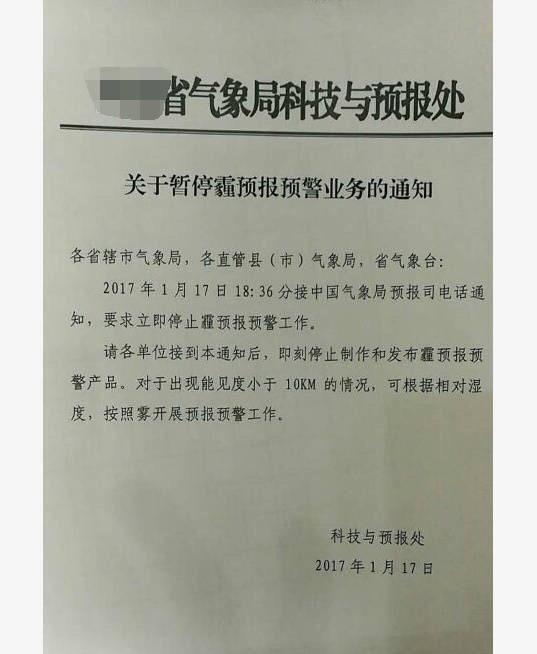The local meteorological bureaus were asked to stop the official response to the haze forecast and early warning work.
On the evening of January 17th, a picture of "Notice on Suspending Haze Forecast and Warning Service" was circulated in Weibo. The text in the picture reads: "The meteorological bureaus of cities under the provincial jurisdiction, the meteorological bureaus of counties (cities) and the provincial meteorological bureaus: At 18: 36 on January 17, 2017, they received a telephone call from the forecast department of China Meteorological Bureau, demanding that the haze forecast and early warning work be stopped immediately. After receiving this notice, all units are requested to immediately stop making and publishing haze forecasting and early warning products. For the case that the visibility is less than 10KM, the forecast and early warning work can be carried out according to the relative humidity and fog, and the signature is "Science and Technology and Forecast Department".

That night, The Paper confirmed the authenticity of the notice from the relevant staff of China Meteorological Bureau. The staff member said, "This notice on suspending the haze forecast and early warning business is only an internal notice and has not been publicly released. It is because the meteorological bureau and the environmental protection department often have different situations when releasing information about haze. This time, a joint working mechanism will be introduced. In the future, there will be a consultation mechanism on how to send early warnings and who will send them. Under the new mechanism, not only the Ministry of Environmental Protection and the Meteorological Bureau, but also other relevant units will be released by one department after consultation. At present, the details of the joint working mechanism are still being solicited and should be announced soon. "
A number of meteorological and environmental protection system analysts said that the meteorological department no longer issues haze warning and forecast, which means that the two departments are further clarifying the division of responsibilities to avoid misunderstanding caused by two kinds of "early warning" in public release. Song Yingjie, the host of CCTV’s weather forecast program, forwarded the news on the certified Weibo, and commented: "I guess the two departments are discussing new regulations and how to jointly issue a haze pollution warning to avoid the inconsistency of the previous warning levels."
In the past, people may encounter this situation. At the same time, the Beijing Meteorological Observatory issued an orange warning of haze, while the Beijing Emergency Office issued a red warning of heavy air pollution. The two institutions issued warnings about different "colors" of haze weather.
Why are there two color warnings on the same day? What’s the difference between these two kinds of early warning?
According to China Weather Network, first of all, the publishing units are different. The release unit of haze orange warning is Beijing Meteorological Observatory, and the release unit of heavy pollution red warning is Beijing Emergency Office.
Secondly, the release process is different. Haze orange warning is decided by the internal consultation of the Central Meteorological Observatory and released by itself; The red warning of heavy pollution is that emergency headquarters is heavily polluted by the air set up in Beijing Environmental Protection Bureau, and the Beijing Emergency Office puts forward the suggestion of issuing red warning information, and then the Beijing Emergency Office issues the red warning of heavy pollution.
The publishing standards are also different.
Release standard of orange haze warning (Beijing Meteorological Observatory): It is estimated that one of the following conditions may occur in the next 24 hours and will continue or the actual situation has reached one of the following conditions and may continue:
(1) Haze with visibility less than 2000m and relative humidity less than 80%.
(2) Visibility is less than 2000m, relative humidity is greater than or equal to 80%, and PM2.5 concentration is greater than 150μ g/m3 and less than or equal to 250μ g/m3.
(3) Visibility is less than 5000m, and PM2.5 concentration is more than 250μ g/m3 and less than or equal to 500μ g/m3.
Release Standard of Red Warning for Heavy Pollution (Beijing Emergency Office): The warning level is defined according to the Emergency Plan for Heavy Air Pollution in Beijing.
(1) The air quality index (AQI) above 200 is heavy air pollution, and it is predicted that the heavy air pollution will last for one day (24 hours), which is the early warning level 4 (blue);
(2) For two days (48 hours), it is warning level 3 (yellow);
(3) Three days (72 hours) is the warning level 3 (orange);
(4) For more than three days (more than 72 hours), the warning level is red.
In a word, the main indicators of haze warning issued by Beijing Meteorological Observatory are visibility and PM2.5 concentration. The main indicator for the emergency office to issue early warning of heavy pollution is AQI. It should be noted that AQI (air quality index) includes five other reference standards, such as SO2, NO2, PM10, O and CO, in addition to PM2.5, so the concentration of PM2.5 cannot completely control AQI index.